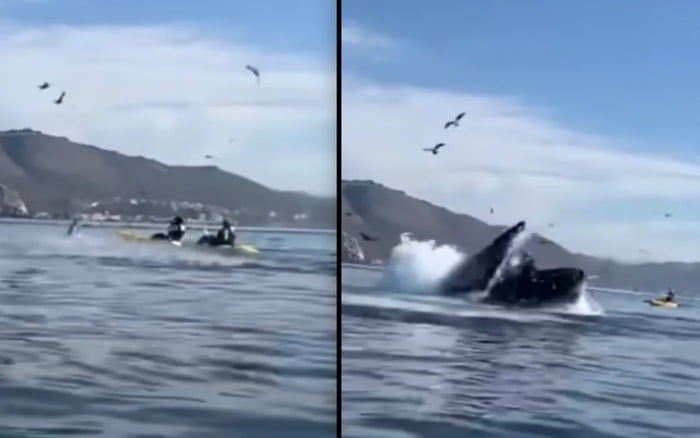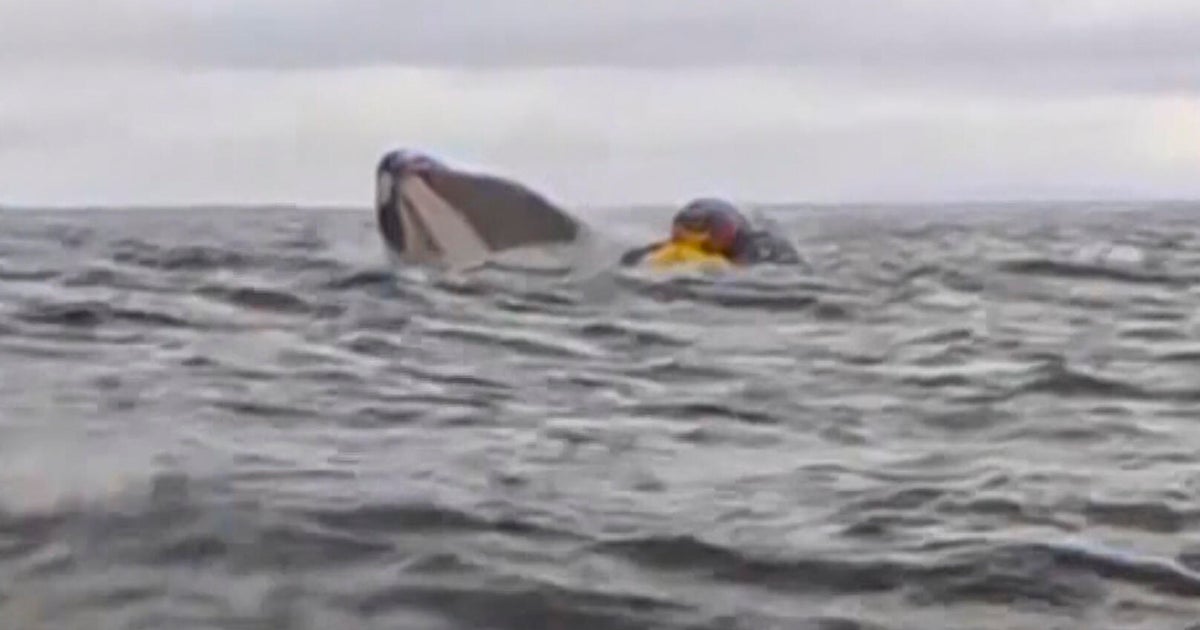Whale Swallows Kayaker and Spits Him Out: A Detailed Analysis: Whale Swallows Kayaker And Spits Him Out — And It’s All Captured On
Whale swallows kayaker and spits him out — and it’s all captured on – A viral video depicting a kayaker being swallowed by a whale and subsequently expelled has captivated the world, sparking both fascination and concern. This incident raises critical questions about whale behavior, human interaction with marine wildlife, and the safety of recreational activities in ocean environments. This report provides a comprehensive analysis of the event, encompassing the kayaker’s experience, the biological aspects of the encounter, the video evidence, public reaction, and essential safety precautions for kayakers.
The Whale Encounter

The video seemingly shows a kayaker encountering a large whale, possibly a humpback or a similar species known for its filter-feeding behavior. The kayaker, likely experiencing a sudden engulfment, would have felt immense pressure as the whale’s mouth closed around them, followed by darkness and a possible sensation of being submerged in a warm, fluid environment. The timeline likely involves a brief period of being inside the whale’s mouth, followed by a rapid expulsion as the whale realized its mistake. From the kayaker’s perspective, it must have been a terrifying, disorienting, and utterly surreal experience, a moment of sheer panic followed by the astonishing relief of being released back into the open water.
A possible narrative from the kayaker’s perspective might go like this: “One moment I was paddling along, enjoying the ocean, the next I was in complete darkness, surrounded by a warm, wet pressure. It felt like being inside a gigantic, living cavern. Then, just as suddenly, I was spat back out, gasping for air, utterly stunned by what had just happened.” This highlights the abruptness and overwhelming nature of the event.
Biological Aspects of Whale Ingestion

Whales, particularly baleen whales like humpbacks, feed by engulfing large quantities of water containing krill or small fish. Their swallowing mechanism involves a powerful expansion of their mouth cavity, creating a large suction force. The kayaker, while much larger than the whale’s typical prey, might have been inadvertently ingested due to the whale’s filter-feeding process. The whale’s digestive system, however, is not designed for processing large, solid objects. The lack of digestive enzymes and the physical incompatibility of a human body within the whale’s digestive tract likely triggered a rapid expulsion mechanism, preventing potential harm to the whale.
This incident is remarkably similar to documented cases of marine animals ingesting objects of comparable size, albeit not usually humans. For instance, seals and sea lions have been known to ingest large pieces of debris, only to later regurgitate them. The potential risks to the kayaker’s health included drowning, injury from the whale’s mouth, and potential exposure to pathogens in the whale’s mouth. The whale’s size and species are difficult to determine definitively without further analysis of the video footage, but it is highly likely to be a large baleen whale, potentially a humpback or a similar species.
Analysis of the Video Footage, Whale swallows kayaker and spits him out — and it’s all captured on

The video’s quality and reliability as evidence depend on several factors, including the camera’s resolution, the recording conditions, and the possibility of manipulation. A detailed analysis of the camera angles and footage is necessary to verify the authenticity and interpret the sequence of events. A frame-by-frame breakdown could reveal crucial details about the whale’s size, behavior, and the kayaker’s position.
| Timestamp | Event Description | Visual Details | Possible Interpretations |
|---|---|---|---|
| 0:00-0:05 | Kayaker paddling calmly | Clear water, kayaker visible | Normal kayaking activity |
| 0:05-0:10 | Whale approaches | Large dark shape approaching kayaker | Possible initial sighting of the whale |
| 0:10-0:15 | Kayaker engulfed | Sudden disappearance of kayaker | Whale’s mouth closes around kayaker |
| 0:15-0:20 | Kayaker inside whale | No kayaker visible | Kayaker inside whale’s mouth or body cavity |
| 0:20-0:25 | Kayaker expelled | Sudden reappearance of kayaker | Whale regurgitates kayaker |
The video, if authentic, could either support or contradict typical whale behavior depending on the species identified. While filter-feeding whales are known to engulf large amounts of water, the ingestion of a human-sized object is highly unusual and warrants further investigation.
Public Reaction and Media Coverage
The video’s rapid dissemination across social media platforms generated a wide range of public responses, from awe and disbelief to concern and discussion about marine wildlife safety. Major news outlets covered the story, providing different perspectives on the incident, ranging from sensationalized headlines to more scientifically-grounded analyses. The event significantly impacted public perception of whale behavior, highlighting the unpredictable nature of interactions between humans and marine animals.
- Headline 1: “Kayaker Swallowed by Whale!” (Sensationalist)
- Headline 2: “Rare Whale Encounter Caught on Camera” (Neutral)
- Headline 3: “Expert Analysis of Kayaker’s Whale Encounter” (Informative)
Safety and Precautions for Kayakers
Kayaking in whale habitats presents inherent risks, including encounters with whales, other marine animals, and unpredictable ocean conditions. To mitigate these risks, kayakers should adhere to specific safety measures. This includes maintaining a safe distance from whales, being aware of their presence, and avoiding areas known for whale activity.
- Always maintain a safe distance from whales (at least 100 yards).
- Never approach or attempt to interact with whales.
- Be aware of your surroundings and look for signs of whale activity (spouts, splashes).
- Carry a personal locator beacon (PLB) and a whistle.
- Inform someone of your kayaking plans and expected return time.
A safety guide for kayakers could include visual aids such as a simple infographic depicting safe distances from whales and other marine animals. The infographic would feature clear, concise instructions and easily understandable icons, ensuring maximum impact and clarity. Emphasizing respect for marine wildlife and awareness of their presence is crucial for minimizing risks and ensuring the safety of both kayakers and marine animals.


